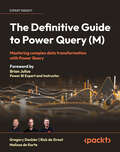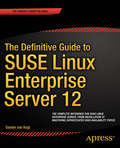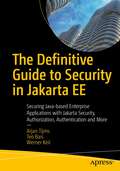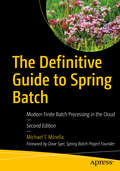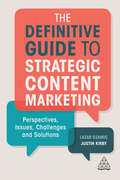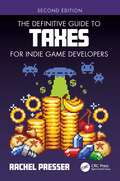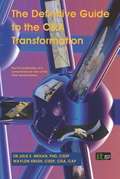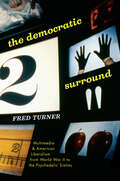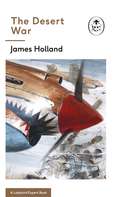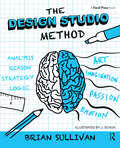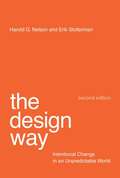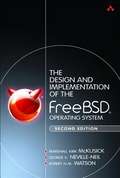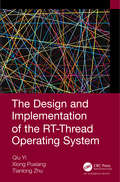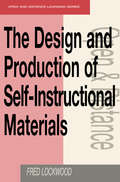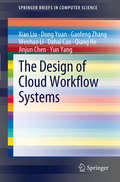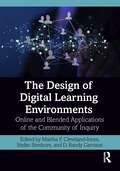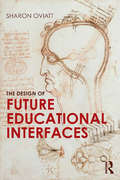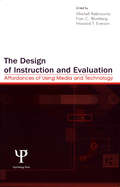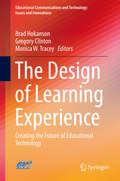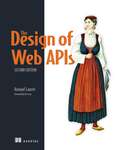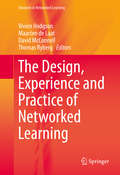- Table View
- List View
The Definitive Guide to Power Query (M): Mastering complex data transformation with Power Query
by Gregory Deckler Rick de Groot Melissa de KorteLearn how to use the Power Query M formula language and its functions effectively for better data modeling and impactful business intelligence reports. Purchase of the print or Kindle book includes a free PDF eBookKey FeaturesGet comprehensive coverage of fundamental and advanced Power Query conceptsGain hands-on experience with practical examples based on real-world problemsDelve into the intricacies of Power Query M language for enhanced data manipulationBook DescriptionData transformation is a critical step in building data models and business intelligence reports. Power Query is an invaluable tool for anyone who wants to master data transformation, and this book will equip you with the knowledge and skills to make the most of it. The Definitive Guide to Power Query (M) will help you build a solid foundation in the Power Query M language. As you progress through the chapters, you'll learn how to use that knowledge to implement advanced concepts and data transformations. This will set the stage for an uncompromisingly thorough exploration of the Power Query M Language. You'll also get to grips with optimizing performance, handling errors, and implementing efficient data processing techniques. As this is a hands-on guide, the practical examples in the chapters will help you gain the skills to apply Power Query to real-world problems and improve your data analysis capabilities. By the end of this book, you will be able to leverage all of Power Query's remarkable capabilities for data transformation.What you will learnGain a strong understanding of Power Query fundamentalsMaster various functions within Power Query to perform complex data operationsAcquire knowledge about values, types, and control structures in Power QueryDevelop proficiency in error handling techniquesLearn performance optimization strategies for Power QueryApply what you've learned to real-world scenarios, including common troublesome patternsWho this book is forThis book is for business analysts, business intelligence professionals, and power business users working with data who want to add Power Query mastery to their resume. This book will be beneficial for anyone who wants to automate their process of data cleaning and save huge amount of time. Having some basic experience in Power Query is recommended.
The Definitive Guide to SUSE Linux Enterprise Server 12
by Sander Van VugtThe Definitive Guide to SUSE Linux Enterprise Server 12 is a task-oriented book designed for self-study as well as classroom environments, which will also serve you as a reference guide. The book covers all skills that system administrators typically need to posses to administer SUSE Linux Enterprise Server in corporate environments. It starts at the beginning, which makes The Definitive Guide to SUSE Linux Enterprise Server 12 suitable for people without any preliminary Linux knowledge, and yet works up to advanced SUSE Linux administration tasks, such as building a cluster, optimizing performance or managing SUSE Linux Enterprise Server with SUSE Manager. The Definitive Guide to SUSE Linux Enterprise Server 12 is an ideal reference guide for system administrators, but is also perfect as a study book to prepare for the CLA, CLP as well as the CLE exams. This book contains step-by-step exercises, and scenario based exercises at the end of each chapter to help readers getting familiar with the subjects that are required to pass these three exams. The Definitive Guide to SUSE Linux Enterprise Server 12also contains test exams, so you can use it as a study guide in a formal learning environment or as a book that you can learn and test your own progress as you master SUSE Linux Enterprise Server. You''ll learn everything you need to know and the skills you need to manage SUSE Linux Enterprise Servers, from installing a secure server, to performing the day-to-day management tasks on SUSE Linux Enterprise Server. Along the way you''ll encounter and master SUSE Linux Enterprise Server in a data center environment, how to manage your SUSE Enterprise Server for High Availability, and you''ll see how to manage your SUSE Linux Enterprise Server with SUSE Manager. From installation to expert management, The Definitive Guide to SUSE Linux Enterprise Server 12 will show you the ways to succeed with Linux Enterprise Server 12. What you''ll learn Everything you need to know and the skills you need to manage SUSE Linux Enterprise Servers. Install a secure SUSE Linux Enterprise Server. Perform day-to-day management tasks on SUSE Linux Enterprise Server. How to pass the SUSE CLA, CLP as well as CLE exams. How to manage a SUSE Linux Enterprise Server in a data center. Integrate SUSE Linux Enterprise Server in a High Availability environment. Manage SUSE Linux Enterprise Server with SUSE Manager. Who this book is for The Definitive Guide to SUSE Linux Enterprise Server 12 is a task-oriented book designed for self-study as well as classroom environments which also serves as a reference guide. The book covers all skills that system administrators typically need to posses to administer SUSE Linux Enterprise Server in corporate environments. It starts at the beginning, which makes the book apt for people without any preliminary Linux knowledge, and works up to advanced SUSE Linux administration tasks, such as building a cluster, optimizing performance or managing SUSE Linux Enterprise Server with SUSE Manager. Table of Contents Part I: Basic skills Chapter 1: Introduction and Installation Chapter 2: Basic command line and YaST skills Part II: Administering SUSE Linux Enteprise Server Chapter 3: Managing File Systems Chapter 4: User and Permission Management Chapter 5: Common Administration Tasks: printing, cron, logging, software, process management Chapter 6: Hardening SUSE Linux: SELinux, Apparmor, sudo, authentication clients Chapter 7: Virtualization Management Chapter 8: Managing hardware, the kernel and the boot procedure Part III: Networking SUSE Linux Enterprise Server Chapter 9: Configuring Network Access Chapter 10: Securing Internet servers: SUSEfirewall, IPtables, SSL Chapter 11: Basic Network Services: Xinetd, NTP, DNS, DHCP, LDAP Chapter 12: Internet Services: Setting up a LAMP Server Chapter 13: File sharing: Samba NFS and FTP Part IV: Advanced SUSE Linux Enterprise Server Administration Chapter 14: Shell scripting Chapter 15: Optimizing Performance Chapter 16: High Availability Clustering Chapter 17: Cre...
The Definitive Guide to Security in Jakarta EE: Securing Java-based Enterprise Applications with Jakarta Security, Authorization, Authentication and More
by Arjan Tijms Teo Bais Werner KeilRefer to this definitive and authoritative book to understand the Jakarta EE Security Spec, with Jakarta Authentication & Authorization as its underlying official foundation. Jakarta EE Security implementations are discussed, such as Soteria and Open Liberty, along with the build-in modules and Jakarta EE Security third-party modules, such as Payara Yubikey & OIDC, and OmniFaces JWT-Auth.The book discusses Jakarta EE Security in relation to SE underpinnings and provides a detailed explanation of how client-cert authentication over HTTPS takes place, how certifications work, and how LDAP-like names are mapped to caller/user names. General (web) security best practices are presented, such as not storing passwords in plaintext, using HTTPS, sanitizing inputs to DB queries, encoding output, and explanations of various (web) attacks and common vulnerabilities are included.Practical examples of securing applications discuss common needs such as letting users explicitly log in, sign up, verify email safely, explicitly log in to access protected pages, and go direct to the log in page. Common issues are covered such as abandoning an authentication dialog halfway and later accessing protected pages again.What You Will LearnKnow what Jakarta/Java EE security includes and how to get started learning and using this technology for today's and tomorrow's enterprise Java applicationsSecure applications: traditional server-side web apps built with JSF (Faces) as well as applications based on client-side frameworks (such as Angular) and JAX-RSWork with the daunting number of security APIs in Jakarta EEUnderstand how EE security evolvedWho This Book Is ForJava developers using Jakarta EE and writing applications that need to be secured (every application). Basic knowledge of Servlets and CDI is assumed. Library writers and component providers who wish to provide additional authentication mechanisms for Jakarta EE also will find the book useful.
The Definitive Guide to Spring Batch: Modern Finite Batch Processing in the Cloud
by Michael T. MinellaWork with all aspects of batch processing in a modern Java environment using a selection of Spring frameworks. This book provides up-to-date examples using the latest configuration techniques based on Java configuration and Spring Boot. The Definitive Guide to Spring Batch takes you from the “Hello, World!” of batch processing to complex scenarios demonstrating cloud native techniques for developing batch applications to be run on modern platforms. Finally this book demonstrates how you can use areas of the Spring portfolio beyond just Spring Batch 4 to collaboratively develop mission-critical batch processes.You’ll see how a new class of use cases and platforms has evolved to have an impact on batch-processing. Data science and big data have become prominent in modern IT and the use of batch processing to orchestrate workloads has become commonplace. The Definitive Guide to Spring Batch covers how running finite tasks on cloud infrastructure in a standardized way has changed where batch applications are run.Additionally, you’ll discover how Spring Batch 4 takes advantage of Java 9, Spring Framework 5, and the new Spring Boot 2 micro-framework. After reading this book, you’ll be able to use Spring Boot to simplify the development of your own Spring projects, as well as take advantage of Spring Cloud Task and Spring Cloud Data Flow for added cloud native functionality.Includes a foreword by Dave Syer, Spring Batch project founder.What You'll LearnDiscover what is new in Spring Batch 4 Carry out finite batch processing in the cloud using the Spring Batch projectUnderstand the newest configuration techniques based on Java configuration and Spring Boot using practical examplesMaster batch processing in complex scenarios including in the cloud Develop batch applications to be run on modern platforms Use areas of the Spring portfolio beyond Spring Batch to develop mission-critical batch processesWho This Book Is ForExperienced Java and Spring coders new to the Spring Batch platform. This definitive book will be useful in allowing even experienced Spring Batch users and developers to maximize the Spring Batch tool.
The Definitive Guide to Strategic Content Marketing: Perspectives, Issues, Challenges and Solutions
by Lazar Dzamic Justin KirbyMarketers everywhere are talking about content, but not everyone is saying the same thing. Some professionals love content and believe it has revolutionized the practice of marketing. To others, it's mere hype: a new name for what marketers have always done. The Definitive Guide to Strategic Content Marketing brings together all of these diverse perspectives, structuring them around useful key topics that provide insight into the multi-faceted nature of content marketing. The editors of The Definitive Guide to Strategic Content Marketing weave different voices together to present a balanced view of content marketing, grouping the discussion around relevant subjects such as content monetization, native advertising, visuals vs video, and the challenge of measuring results. This structure allows readers to move through the book according to their interests, and cherry-pick the most useful aspects of each discussion to apply to their own marketing initiatives. Containing contributions from, and interviews with, leading academics, industry experts, thought leaders and influencers, this book is a truly unique resource.
The Definitive Guide to Taxes for Indie Game Developers
by Rachel PresserIndie developers and other people who work on games for a living face all kinds of interesting income tax and small business formation issues that more traditional businesses simply don’t: not being geographically bound, relying on alternative funding, long periods of time with no income, and having multiple options for tax treatment of game development costs. The Definitive Guide to Taxes for Indie Game Developers addresses the income tax issues that the average indie game developer is most likely to encounter, in the context of the American Internal Revenue Code and types of taxes. Written by a former tax law practitioner turned game developer and industry consultant with a decade of tax and accounting experience, this newly revised Second Edition includes key provisions of the 2018 tax reform, such as the new qualified business income deduction, R&D credit expansion, and permanent reduction to corporate income taxes. In-depth explanations and examples are provided along with references to Tax Court and Supreme Court cases relevant to each tax benefit. Key Features: Includes authoritative sources with relevant IRS publications, Revenue Rulings, and Tax Court cases Features easy to read, accessible, and humorous language: No legalese! Approaches how business decisions as an indie developer affect personal finances Readers will gain a thorough understanding of taxation’s role in managing a game studio of any size and going indie with any lifestyle. The accompanying companion website is a valuable resource that is annually updated to keep current on any tax reforms.
The Definitive Guide to the C&A Transformation: The First Publication of a Comprehensive View of the C&A Transformation
by Phd Dr Julie E. Mehan Cissp Waylon KrushThe Definitive Guide to the C&A Transformation provides an authoritative guide to authorization for persons with knowledge of information systems and/or information systems security, but not necessarily the same level of expertise with certification and accreditation (C&A) standards and best practices; it points to references for further knowledge. It is scoped to present the information needed to meaningfully recognize, implement, and manage authorization requirements and achieve compliance with federal, local and agency laws and policies.
The Democratic Surround: Multimedia & American Liberalism from World War II to the Psychedelic Sixties
by Fred TurnerWe commonly think of the psychedelic sixties as an explosion of creative energy and freedom that arose in direct revolt against the social restraint and authoritarian hierarchy of the early Cold War years. Yet, as Fred Turner reveals in The Democratic Surround, the decades that brought us the Korean War and communist witch hunts also witnessed an extraordinary turn toward explicitly democratic, open, and inclusive ideas of communication and with them new, flexible models of social order. Surprisingly, he shows that it was this turn that brought us the revolutionary multimedia and wild-eyed individualism of the 1960s counterculture. In this prequel to his celebrated book From Counterculture to Cyberculture, Turner rewrites the history of postwar America, showing how in the 1940s and '50s American liberalism offered a far more radical social vision than we now remember. Turner tracks the influential mid-century entwining of Bauhaus aesthetics with American social science and psychology. From the Museum of Modern Art in New York to the New Bauhaus in Chicago and Black Mountain College in North Carolina, Turner shows how some of the most well-known artists and intellectuals of the forties developed new models of media, new theories of interpersonal and international collaboration, and new visions of an open, tolerant, and democratic self in direct contrast to the repression and conformity associated with the fascist and communist movements. He then shows how their work shaped some of the most significant media events of the Cold War, including Edward Steichen's Family of Man exhibition, the multimedia performances of John Cage, and, ultimately, the psychedelic Be-Ins of the sixties. Turner demonstrates that by the end of the 1950s this vision of the democratic self and the media built to promote it would actually become part of the mainstream, even shaping American propaganda efforts in Europe. Overturning common misconceptions of these transformational years, The Democratic Surround shows just how much the artistic and social radicalism of the sixties owed to the liberal ideals of Cold War America, a democratic vision that still underlies our hopes for digital media today.
The Desert War: Book 4 of the Ladybird Expert History of the Second World War (The Ladybird Expert Series #10)
by James HollandPart of the ALL-NEW LADYBIRD EXPERT SERIES.____________Why was North Africa such a key component in Britain's success over Mussolini and his Italian Army?How did they blunt Italy's actions?What challenges did they face?And what new technologies were brought to bear?When fascist dictator Mussolini declared war against Britain he was taking a huge risk . . . Italy lacked natural resources, and Britain and France's wealth.He hoped to create a new Roman Empire across the Mediterranean and into Africa. And with Hitler and the Nazi's by his side he had a great chance of doing so - but what was it that stopped him?Discover the answers and more inside James Holland's The Desert War, the thrilling and accessible account that explains what happened, who the key figures were and the tactics, triumphs and failures on both sides . . .
The Design Collection Revealed: Adobe InDesign CS4, Photoshop CS4 & Illustrator CS4
by Elizabeth Eisner Reding Chris BotelloNIMAC-sourced textbook
The Design Collection Revealed: Adobe InDesign CS5, Photoshop CS5 & Illustrator CS5
by Elizabeth Eisner Reding Chris BotelloTHE DESIGN COLLECTION REVEALED provides comprehensive step-by-step instruction and in-depth explanation for three of today's most widely used design and layout programs: Adobe InDesign CS5, Adobe Photoshop CS5, and Adobe Illustrator CS5. Readers gain practical experience with the software as they work through end-of-chapter learning projects and step-by-step tutorials. An integration chapter demonstrates how to move from one application to the other. Full-color illustrations and a user-friendly design combine to create a robust learning experience that reveals how to master the latest features of Adobe's popular design suite.
The Design Studio Method: Creative Problem Solving with UX Sketching
by Brian K SullivanThe struggle with balancing creative products that are innovative, technically feasible, and financially sound is one designers and web professionals go through every day. The Design Studio Method is a creative problem solving process that allows you to quickly generate ideas, evaluate them, and reach consensus, achieving that balancing act. Brian Sullivan’s The Design Studio Method gives answers that you have been looking for, showing you how to be innovative and efficient without sacrificing quality and collaboration. This book simplifies the complicated method, explaining each step, each participant’s involvement, and how to adapt the method to your needs. The Design Studio Method provides step-by-step procedures to ensure your success. From illumination, to generation, to presentation, all the way to iteration, this book provides the road map you’ll need to start generating innovate products. Shows you how to involve all members of the creative process—from clients to directors—so that everyone participates, critiques, and innovates. Features real-world examples of Design Studio projects that highlight the successes of this method and ways to adapt it to your needs. Includes a website that showcases videos covering each step of the method and other procedures that crop up along the way.
The Design Way: Intentional Change in an Unpredictable World (Second Edition)
by Erik Stolterman Harold G. NelsonHumans did not discover fire--they designed it. Design is not defined by software programs, blueprints, or font choice. When we create new things--technologies, organizations, processes, systems, environments, ways of thinking--we engage in design. With this expansive view of design as their premise, in The Design Way Harold Nelson and Erik Stolterman make the case for design as its own culture of inquiry and action. They offer not a recipe for design practice or theorizing but a formulation of design culture's fundamental core of ideas. These ideas--which form "the design way"--are applicable to an infinite variety of design domains, from such traditional fields as architecture and graphic design to such nontraditional design areas as organizational, educational, interaction, and healthcare design. The text of this second edition is accompanied by new detailed images, "schemas" that visualize, conceptualize, and structure the authors' understanding of design inquiry. The text itself has been revised and expanded throughout, in part in response to reader feedback.
The Design and Implementation of the FreeBSD Operating System
by Marshall Kirk Mckusick George V. Neville-Neil Robert N.M. WatsonThis technical guide to FreeBSD's internal structure has now been extensively updated to cover all major improvements between Versions 5 and Version 11.
The Design and Implementation of the RT-Thread Operating System
by Qiu Yi Xiong Puxiang Tianlong ZhuSince the release of V0.01 in 2006, to the present V4.0 version, RT-Thread has developed a reputation among developers for its open source strategy. RT-Thread has gained a large following among members of the embedded open source community in China with hundreds of thousands of enthusiasts. RT-Thread is widely used in energy, automotive, medical, consumer electronics, among other applications, making it a mature and stable open source embedded operating system. The purpose of RT-Thread RTOS Design and Implementation is to create an easy learning curve for mastering RT-Thread, so that more developers can participate in the development of RT-Thread and work together to create an open source, tiny, and beautiful Internet of Things operating system. The book’s first part introduces the RT-Thread kernel and starts with an overview of RT-Thread before covering thread management, clock management, inter-thread synchronization, inter-thread communication, memory management, and interrupt management. The second part begins with RT-Thread kernel porting and explains how to port RT-Thread to a hardware board to run it. The second part also introduces RT-Thread components and discusses the Env development environment, FinSH console, device management, and network framework. Additional topics covered include: The I/O device framework Virtual file systems Peripheral interfaces Devices including the PIN device, UART device, and ADC device, among others. Each chapter features code samples, as well as helpful tables and graphs, so you can practice as you learn as well as perform your own experiments.
The Design and Production of Self-instructional Materials (Open and Flexible Learning Series)
by Fred LockwoodDesigned to help those who are planning to produce open or flexible learning materials, particularly trainers who must work on their own with little support or encouragement. All aspects of the design and production of materials is examined, including the role of audio and video cassettes.
The Design of Cloud Workflow Systems
by Qiang He Dahai Cao Dong Yuan Wenhao Li Xiao Liu Yun Yang Gaofeng Zhang Jinjun ChenCloud computing is the latest market-oriented computing paradigm which brings software design and development into a new era characterized by "XaaS", i.e. everything as a service. Cloud workflows, as typical software applications in the cloud, are composed of a set of partially ordered cloud software services to achieve specific goals. However, due to the low QoS (quality of service) nature of the cloud environment, the design of workflow systems in the cloud becomes a challenging issue for the delivery of high quality cloud workflow applications. To address such an issue, this book presents a systematic investigation to the three critical aspects for the design of a cloud workflow system, viz. system architecture, system functionality and quality of service. Specifically, the system architecture for a cloud workflow system is designed based on the general four-layer cloud architecture, viz. application layer, platform layer, unified resources layer and fabric layer. The system functionality for a cloud workflow system is designed based on the general workflow reference model but with significant extensions to accommodate software services in the cloud. The support of QoS is critical for the quality of cloud workflow applications. This book presents a generic framework to facilitate a unified design and development process for software components that deliver lifecycle support for different QoS requirements. While the general QoS requirements for cloud workflow applications can have many dimensions, this book mainly focuses on three of the most important ones, viz. performance, reliability and security. In this book, the architecture, functionality and QoS management of our SwinDeW-C prototype cloud workflow system are demonstrated in detail as a case study to evaluate our generic design for cloud workflow systems. To conclude, this book offers a general overview of cloud workflow systems and provides comprehensive introductions to the design of the system architecture, system functionality and QoS management.
The Design of Digital Learning Environments: Online and Blended Applications of the Community of Inquiry
by D. Randy Garrison Cleveland-Innes, Martha F. Stefan StenbomThe Design of Digital Learning Environments provides comprehensive guidelines for creating and delivering high-quality online and blended learning experiences in higher education. With increasing numbers of students engaged in partially or fully digital education, graduate students preparing for design, development, or faculty roles need fresh, practical applications of cutting-edge research and theory. This textbook uses the Community of Inquiry framework, an influential and invaluable pedagogical model focused on deep learning, to aid educators in forging meaningful, collaborative connections with students engaged in digitally supported multi-modal learning in colleges and universities, MOOCs, and lifelong learning initiatives. Across five parts, the book covers the basic structure, concepts, terminology, and history of the Community of Inquiry; principles for designing and delivering digital courses; design for specific course conditions; applications of learning activities guided by the framework; and current limitations and directions for further research.
The Design of Future Educational Interfaces
by Sharon OviattThe Design of Future Educational Interfaces provides a new multidisciplinary synthesis of educational interface research. It explains how computer interfaces can be redesigned to better support our ability to produce ideas, think, and solve problems successfully in national priority areas such as science and mathematics. Based on first-hand research experience, the author offers a candid analysis of emerging technologies and their impact, highlighting communication interfaces that stimulate thought. The research results will surprise readers and challenge their assumptions about existing technology and its ability to support our performance. In spite of a rapid explosion of interest in educational technologies, there remains a poor understanding of what constitutes an effective educational interface for student cognition and learning. This book provides valuable insights into why recent large-scale evaluations of existing educational technologies have frequently not shown demonstrable improvements in student performance. The research presented here is grounded in cognitive science and experimental psychology, linguistic science and communications, cross-cultural cognition and language, computer science and human interface design, and the learning sciences and educational technology.
The Design of Instruction and Evaluation: Affordances of Using Media and Technology
by Fran C. Blumberg Howard T. Everson Mitchell RabinowitzThis book is about empirically tested knowledge and principles that inform the design of instructional and evaluation systems, and the use and promise of media and technology within such systems. Historically, psychology has informed the design of instructional and evaluation systems in different ways. A behavioral perspective emphasizes the role of the environment in determining behavior--a factor external to the learner. A cognitive perspective focuses on the role of cognitive processing and constraints in determining learning--factors that are internal to the learner. This volume presents the affordances approach--which addresses how the environment and the affordances within it interact with cognitive processes to determine learning. Insights into this interaction are presented. It is the book's contention that the affordance approach represents an advancement over the behavioral and cognitive perspectives; it is an evolution within the cognitive approach--not an alternative to it. The Design of Instruction and Evaluation: Affordances of Using Media and Technology is intended for education practitioners responsible for the implementation of media and technology in classrooms, for researchers and faculty, and for use as a text in courses on media and technology use in educational settings, instructional design, and psychology of learning.
The Design of Learning Experience
by Monica W. Tracey Brad Hokanson Gregory ClintonThis book delves into two divergent, yet parallel themes; first is an examination of how educators can design the experiences of learning, with a focus on the learner and the end results of education; and second, how educators learn to design educational products, processes and experiences. The book seeks to understand how to design how learning occurs, both in the instructional design studio and as learning occurs throughout the world. This will change the area's semantics; at a deeper level, it will change its orientation from instructors and information to learners; and it will change how educators take advantage of new and old technologies. This book is the result of a research symposium sponsored by the Association for Educational Communications and Technology [AECT].
The Design of Material, Organism, and Minds
by Michael Hampe Silke Konsorski-LangDesign is eminent throughout different disciplines of science, engineering, humanities, and art. However, within these disciplines, the way in which the term design is understood and applied differs significantly. There still is a profound lack of interdisciplinary research on this issue. The same term is not even guaranteed to carry the same meaning as soon as one crosses over to other disciplines. Therefore, related synergies between disciplines remain largely unexplored and unexploited.This book will address design in the hope of promoting a deeper understanding of it across various disciplines, and to support Design Science as a discipline, which attempts to cover the vast number of currently isolated knowledge sources.
The Design of Web APIs
by Arnaud LauretWeb APIs are everywhere, giving developers an efficient way to interact with applications, services, and data. Well-designed APIs are a joy to use; poorly-designed APIs are cumbersome, confusing, and frustrating. The Design of Web APIs is a practical, example packed guide to crafting extraordinary web APIs. Author Arnaud Lauret demonstrates fantastic design principles and techniques you can apply to both public and private web APIs.Purchase of the print book includes a free eBook in PDF, Kindle, and ePub formats from Manning Publications.
The Design of Web APIs, Second Edition
by Arnaud LauretLearn how to design web APIs that are a delight to use and maintain.Thousands of developers have followed renowned API expert Arnaud Lauret&’s guidance to create APIs that are flexible, secure, and easily integrated. This new edition of the bestselling The Design of Web APIs covers the latest updates to the OpenAPI standard, teaches you to streamline and standardize API design decisions with rationale and automation, and gives you insights you can apply to other API styles, such as gRPC. You&’ll quickly see how a well-designed and properly-documented API gives your users autonomy—and saves you from constant explanations and hand-holding. This fully revised second edition of The Design of Web APIs teaches you the principles and techniques you need to design easy-to-consume public and private web APIs. In it, you&’ll learn how to: • Analyze requirements to identify API capabilities for versatile, reusable designs • Create HTTP-based REST APIs with CRUD, batch/bulk, or long operations • Design interoperable, user-friendly APIs with seamless operations and data flow • Ensure secure, efficient APIs while overcoming limitations and constraints • Modify APIs without breaking compatibility, evaluating consequences carefully • Future-proof your APIs and choose effective versioning strategies • Document REST APIs using OpenAPI and JSON Schema for seamless implementation • Streamline and standardize API design decisions with rationale and automation The Design of Web APIs, Second Edition teaches vital skills for gathering requirements, balancing business and technical goals and constraints, and adopting a consumer-first mindset. Each chapter is packed full of hands-on examples, including designing an Online Shopping API and user-friendly banking operations, and over seventy exercises to help your new skills stick. Plus, you&’ll explore paradigms applicable beyond REST APIs, and fully describe and document your APIs with OpenAPI and JSON Schema. Your web APIs will soon be easier to consume and your clients—internal and external—will be happier than ever! About the technology Web APIs open up your software to developers, exposing features, and capabilities to other programs. Well-designed web APIs are a joy. The bad ones are a nightmare, with endless impact on system performance, developer productivity, and end-user experience. This book shows you how to design APIs your fellow developers will love to use. About the book The Design of Web APIs, Second Edition teaches you to design efficient and adaptable REST APIs. This revised and rewritten second edition contains the latest updates to the OpenAPI standard, along with insights you can apply to other API styles such as GraphQL. Learn vital skills for gathering requirements, creating easy-to-consume public and private web APIs, and handling non-backward compatible modifications and versioning. What's inside • Design reusable, user-friendly and interoperable APIs • Document your APIs with OpenAPI and JSON Schema • Create secure and efficient APIs by design • Streamline and standardize API design decisions About the reader Written for developers with experience building and consuming APIs. About the author Arnaud Lauret runs the API Handyman blog and is a frequent speaker at API conferences. He currently works as an API Industry Researcher at Postman. Table of Contents 1 What is API design? Part 1 2 Identifying API capabilities 3 Observing operations from the REST angle 4 Representing operations with HTTP 5 Modeling data 6 Describing HTTP operations with OpenAPI 7 Describing data with JSON Schema in OpenAPI Part 2 8 Designing user-friendly, interoperable data 9 Designing user-friend
The Design, Experience and Practice of Networked Learning
by David Mcconnell Vivien Hodgson Thomas Ryberg Maarten De LaatThe Design, Experience and Practice of Networked Learning Edited by: Vivien Hodgson, Maarten de Laat, David McConnell and Thomas Ryberg This book brings together a wealth of new research that opens up the meaning of connectivity as embodied and promised in the term ''networked learning''. Chapters explore how contexts, groups and environments can be connected rather than just learners; how messy, unexpected and emergent connections can be made rather than structured and predefined ones; and how technology connects us to learning and each other, but also shapes our identity. These exciting new perspectives ask us to look again at what we are connecting and to revel in new and emergent possibilities arising from the interplay of social actors, contexts, technologies, and learning. Caroline Haythornthwaite, University of British Columbia Despite creating fundamentally new educational economics and greatly increasing access - teaching and learning in networks is a tricky business. These chapters illuminate the complex interactions amongst tools, pedagogy, educational institutions and personal net presences - helping us design and redesign our own networks. In the process, they take (or extract) network theory from the practice of real teaching and learning contexts, making this collection an important contribution to Networked Learning. Terry Anderson, Athabasca University What kinds of learning can social networking platforms really enable? Digging well beneath the hype, this book provides a timely, incisive analysis of why and how learning emerges (or fails to) in networked spaces. The editors do a fine job in guiding the reader through the rich array of theories and methods for tackling this question, and the diverse contexts in which networked learning is now being studied. This is a book for reflective practitioners as well as academics: the book''s close attention to the political, pedagogical and organisational complexity of effective practice, and the lived experience of educators and learners, helps explain why networked learning has such disruptive potential -- but equally, why it draws resistance from the establishment. Simon Buckingham Shum, The Open University The networked learning conference, a biannual institution since 1998, celebrates its 14th year in this volume. Here a range of studies, reflecting networked learning experiments across Europe and other global contexts , show important shifts away from a conservative tradition of OEe-learning¹ research and unpeel dilemmas of promoting learning as an elusive practice in virtual environments. The authors point towards important futures in online learning research, where notions of knowledge, connectivity and OEcommunity¹ become increasingly elastic, and engagements slide across material and virtual domains in new practices whose emergence is increasingly difficult to apprehend. Tara Fenwick - University of Stirling. The chapters in this volume explore new and innovative ways of thinking about the nature of networked learning and its pedagogical values and beliefs. They pose a challenge to us to reflect on what we thought networked learning was 15 year ago, where it is today and where it is likely to be headed. Each chapter brings a particular perspective to the themes of design, experience and practice of networked learning, the chosen focus of the book. The chapters in the book embrace a wide field of educational areas including those of higher education, informal learning, work-based learning, continuing professional development, academic staff development, and management learning. The Design, Experience and Practice of Networked Learning will prove indispensable reading for researchers, teachers, consultants, and instructional designers in higher and continuing education; for those involved in staff and educational development, and for those studying post graduate qualifications in learning and teaching. This, the second volume in the Springer Book Series on Researching Networked Learning, is based on a selection of papers presented a...
